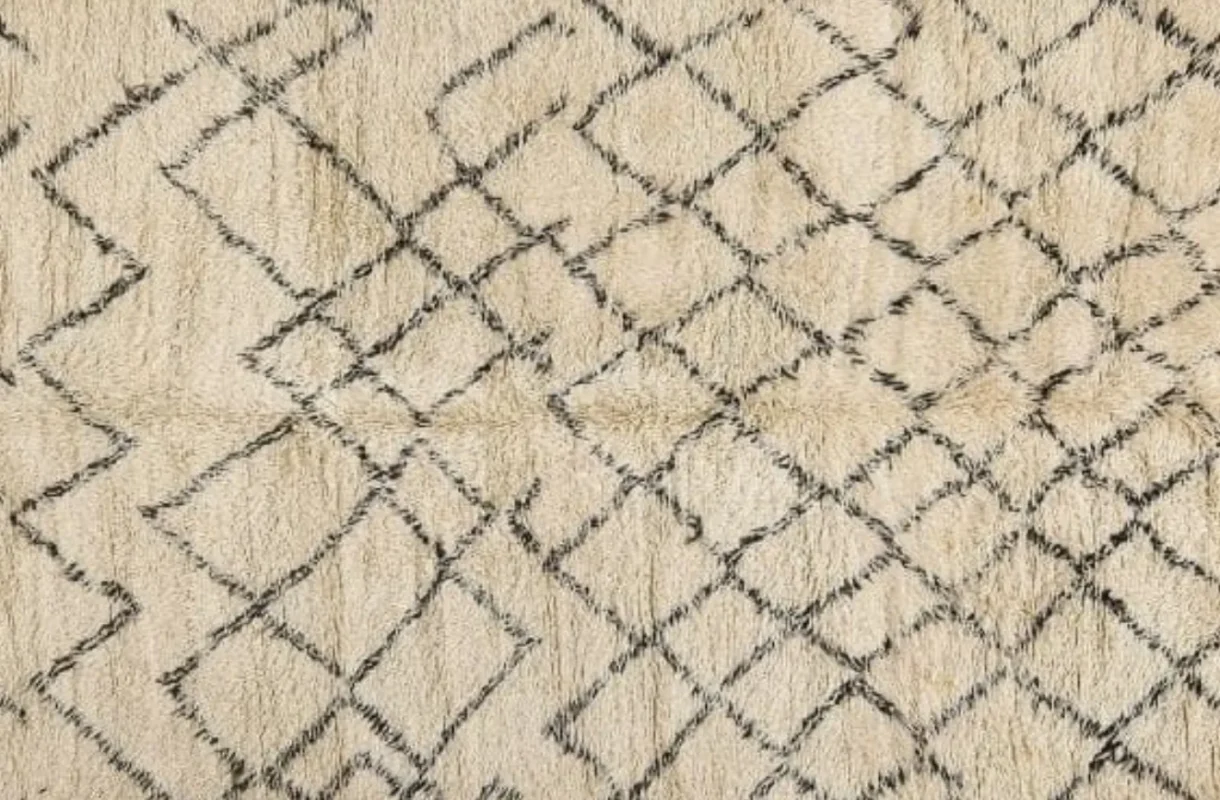No products in the cart.
Rug Knowledge & Heritage
Types of Berber Rugs: From Beni Ourain to Boucherouite
The Soul of Berber Craftsmanship in Every Rug
Morocco’s rich artisan traditions are beautifully captured in its Berber rugs. Handwoven by Amazigh (Berber) tribes across the country, each rug is a symbol of culture, history, and artistry. From the snowy Atlas Mountains to vibrant village life, these rugs tell stories with every thread. Today, we dive into the most popular types of Berber rugs: Beni Ourain, Azilal, Kilim, and Taznakht—helping you find the perfect match for your space.
1. Beni Ourain Rugs – Timeless Simplicity
Beni Ourain rugs are the most famous Berber rugs worldwide. Woven by the Berber tribes of the Middle Atlas Mountains, they feature thick, plush wool with simple geometric designs—usually black diamonds on a creamy background. Their soft texture and neutral tones make them ideal for cozy, minimalist interiors.

Made from 100% sheep wool, Beni Ourain rugs bring warmth and elegance to bedrooms, living rooms, or reading nooks.
2. Azilal Rugs – The Artist’s Rug
Originating in Morocco’s Azilal province, Azilal rugs are colorful, bold, and full of personality. These handmade wool rugs are crafted primarily by Berber women and feature abstract, symbolic motifs representing daily life, nature, and tradition.

These rugs are typically made by women, and every piece tells a story—from marriage and fertility to daily village life. Their artistic energy makes them perfect statement pieces for creative spaces.
3. Kilim Rugs – Flatwoven and Functional
Kilim rugs (also known as “Hanbel”) are flatwoven rugs made in various Moroccan regions, especially in the south. Unlike wool-pile rugs, they have no thickness, making them light, easy to move, and ideal for layering or use in high-traffic areas like dining rooms or entryways.

With vivid patterns and symmetry, Kilims often feature tribal symbols and are usually made from wool, cotton, or a mix of both.
4. Taznakht Rugs – A Pop of Berber Heritage
Taznakht rugs come from the town of Taznakht in southern Morocco, known for their rich colors and detailed patterns. These rugs feature warm hues such as reds, yellows, and oranges, combined with intricate geometric motifs. They are thicker and heavier, making them both decorative and durable.

If you’re looking to add rich color and traditional Moroccan identity to your room, a Taznakht rug is a great choice.
5. Boucherouite Rugs – Sustainable & Full of Life
Boucherouite rugs are made from recycled textiles—cotton, wool, nylon, and synthetic fibers—handwoven by Berber women, often using scraps of old clothes. These rugs burst with color and creativity, creating joyful, eclectic pieces that are as environmentally friendly as they are beautiful.

They’re a wonderful choice for bohemian interiors, children’s rooms, creative spaces, or anywhere you want to add a splash of Moroccan soul.
Tips to Care for Your Moroccan Rug
No matter which rug you choose:
- Vacuum gently, especially with high-pile rugs like Beni Ourain or Azilal.
- Avoid harsh chemicals—use natural soaps or seek a local artisan rug cleaner.
- Rotate your rug every few months to balance wear and sunlight exposure.
💡 If you already own a Beni Ourain rug, check out our complete guide on how to clean and maintain Beni Ourain rugs for detailed care instructions.
Taking proper care will preserve the colors, textures, and softness of your rug for years.
Conclusion
Berber rugs are more than just decorative pieces—they represent centuries of Moroccan culture and artisanal craftsmanship. Each rug, whether the soft elegance of a Beni Ourain, the vibrant colors of an Azilal, the practical beauty of a Kilim, or the rich patterns of a Taznakht, brings its own unique story and character into your home.
Choosing a Berber rug means inviting a piece of history and tradition into your living space, while also supporting the skilled artisans who keep this heritage alive. With the right care, these rugs will not only enhance your home’s style but also last for generations as treasured heirlooms that connect you to Morocco’s rich cultural tapestry.

